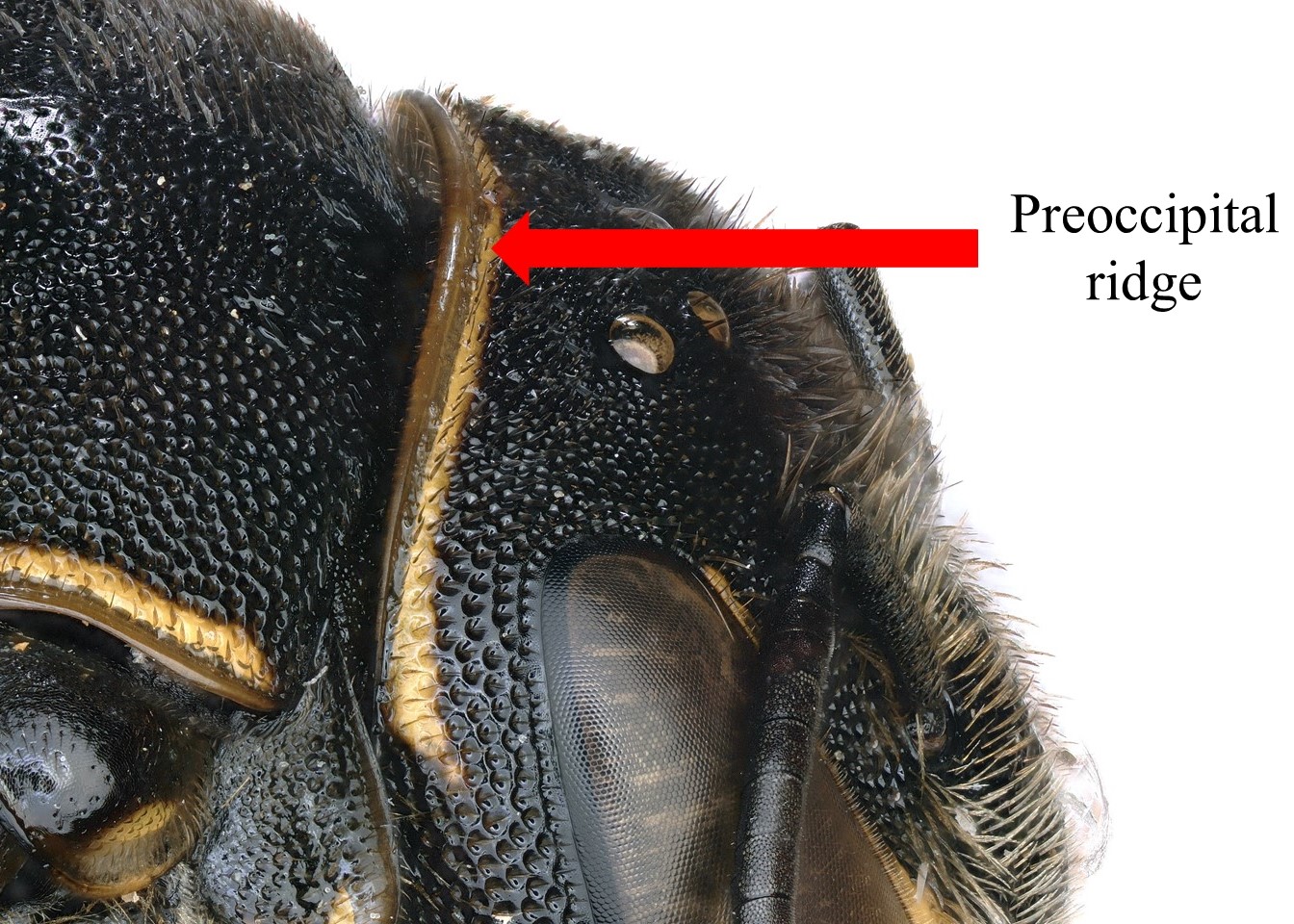Family: Megachilidae
Subfamily: Megachilinae
Tribe: Anthidiini
Genus: Bathanthidium Mavromoustakis, 1953
Subgenera: Bathanthidium, Manthidium, Stenanthidiellum
Common name: none
Bathanthidium are small bees ranging in body length from 5.5–9 mm. Their coloration varies from all black to black with yellow medially broken bandsbands:
usually referring to bands of hair or bands of color that traverse across an abdominal segment
on the tergaterga:
the segments on the top side of the abdomen, often abbreviated when referring to a specific segment to T1, T2, T3, T4, T5, T6, or T7 (Michener 2007Michener 2007:
(Michener 2007Michener 2007:
Michener, C.D. 2007. The Bees of the World (2nd ed.). Johns Hopkins University Press, Baltimore and London, 953 pp.).
Bathanthidium contains 13 species within 3 subgenera (Michener 2007Michener 2007:
Michener, C.D. 2007. The Bees of the World (2nd ed.). Johns Hopkins University Press, Baltimore and London, 953 pp.; Ascher and Pickering 2016bAscher and Pickering 2016b:
Ascher, J.S. and J. Pickering. 2016. Discover Life bee species guide and world checklist: Bathanthidium. Discover Life. https://www.discoverlife.org/mp/20q?search=Bathanthidium); none are known to occur in the U.S. or Canada.
(modified from Michener 2007Michener 2007:
Michener, C.D. 2007. The Bees of the World (2nd ed.). Johns Hopkins University Press, Baltimore and London, 953 pp.)
 is not carinatecarinate:
is not carinatecarinate: with apicalapical:
with apicalapical: is simple, and T7T7:
is simple, and T7T7: ranges from simple to trilobed.
ranges from simple to trilobed.Bathanthidium may be confused with Rhodanthidium and some Trachusa due to a number of shared characters; however, Bathanthidium can be differentiated from these genera by the presence of foveafovea:
a depressed region of cuticle; in bees this depressed area is usually only very slightly hollow and usually on the face.
behind the propodeal spiraclepropodeal spiracle:
the spiracle bordering the posterior margin of the propodeum (these foveafovea:
a depressed region of cuticle; in bees this depressed area is usually only very slightly hollow and usually on the face.
can be small in the subgenus Manthidium (Michener 2007Michener 2007:
Michener, C.D. 2007. The Bees of the World (2nd ed.). Johns Hopkins University Press, Baltimore and London, 953 pp.).
There are no known invasives.
Bathanthidium has been observed visiting Lactuca sibirica, Sedum aizoon, and Lespedeza bicolor (Игнатенко 2012Игнатенко 2012:
Игнатенко, E.B. 2012. Кормовые связи пчёл (Hymenoptera: Apiformes) с цветковыми растениями в амурской области. Амурский зоологический журнал 9: 69ndash;75.).
Bathanthidium have been observed creating nests out of resin in preexisting burrows in wood and plant stems (Romankova 1988Romankova 1988:
Romankova, T.G. 1988. A new far-eastern bee of the tribe Anthidiini. Vestnik Zoologii 4: 25ndash;30.).
Bathanthidium is an Asiatic genus that occurs in China, Taiwan, Burma, Laos, eastern Siberia, and Korea (Michener 2007Michener 2007:
Michener, C.D. 2007. The Bees of the World (2nd ed.). Johns Hopkins University Press, Baltimore and London, 953 pp.; Soh et al. 2016Soh et al. 2016:
Soh, E.J.Y., Z.W.W. Soh, S.X. Chui, and J.S. Ascher. 2016. The bee tribe Anthidiini in Singapore (Anthophila: Megachilidae: Anthidiini) with notes on the regional fauna. Nature in Singapore 9: 49ndash;62.).
Distribution map generated by Discover Life -- click on map for details, credits, and terms of use.
Ascher, J.S. and J. Pickering. 2016. Discover Life bee species guide and world checklist: Bathanthidium. Discover Life. http://www.discoverlife.org/mp/20q?search=Bathanthidium
Michener, C.D. 2007. The Bees of the World. 2nd ed. Johns Hopkins University Press, Baltimore and London, 953 pp.
Игнатенко, E.B. 2012. Кормовые связи пчёл (Hymenoptera: Apiformes) с цветковыми растениями в амурской области. Амурский зоологический журнал 9: 69–75.
Romankova, T.G. 1988. A new far-eastern bee of the tribe Anthidiini. Vestnik Zoologii 4:25-30.
Soh, E.J.Y., Z.W.W. Soh, S.X. Chui, and J.S. Ascher. 2016. The bee tribe Anthidiini in Singapore (Anthophila: Megachilidae: Anthidiini) with notes on the regional fauna. Nature in Singapore 9:49-62.